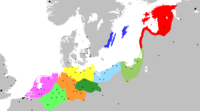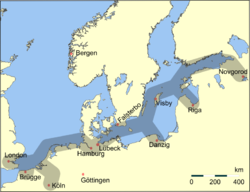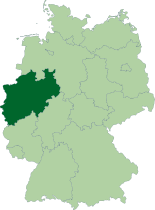Bochum
| Bochum | |
 |
|
 |
|
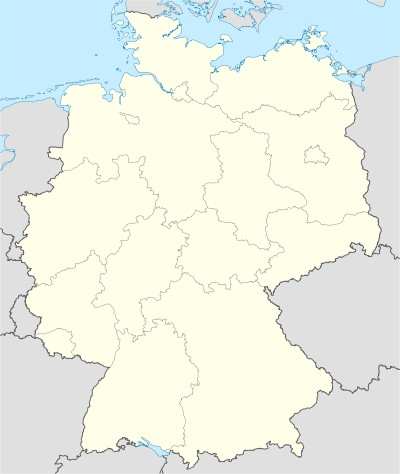 Bochum
|
|
| Coordinates | |
| Administration | |
| Country | Germany |
|---|---|
| State | North Rhine-Westphalia |
| Admin. region | Arnsberg |
| District | Urban district |
| Mayor | Ottilie Scholz (SPD) |
| Basic statistics | |
| Area | 145.4 km2 (56.1 sq mi) |
| Population | 376,319 (31 December 2009)[1] |
| - Density | 2,588 /km2 (6,703 /sq mi) |
| Other information | |
| Time zone | CET/CEST (UTC+1/+2) |
| Licence plate | BO |
| Postal codes | 44701-44894 |
| Area codes | 0234, 02327 |
| Website | www.bochum.de |
Bochum (German pronunciation: [ˈboːxʊm]) is a city in North Rhine-Westphalia, western Germany. It is located in the Ruhr area and is surrounded by the cities of Essen, Gelsenkirchen, Herne, Castrop-Rauxel, Dortmund, Witten and Hattingen.
Contents |
History
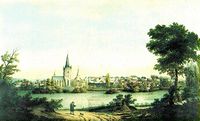
Bochum dates from the 9th century, when Charlemagne set up a royal court at the junction of two important trade routes. It was first officially mentioned in 1041 by the name Cofbuokheim in a document of the archbishops of Cologne. Originally, it may have meant "Brookhome" or "Bacheim" and later seems to have gained the notorious reputation of "Bookhorn" or "Horn Book". In 1321, Count Engelbert II von der Marck granted Bochum a town charter, but the town remained insignificant until the 19th century, when the coal mining and steel industries emerged in the Ruhr area, leading to the growth of the entire region. The population of Bochum increased from about 4,500 in 1850 to 100,000 in 1904. Bochum acquired city status, incorporating neighboring towns and villages. Additional population gains came from immigration, primarily from eastern Europe.
After the war, the new state of North Rhine-Westphalia was established, consisting of the Rhineland and Westphalia. Bochum is located in that state.
In the postwar period, Bochum began developing as a cultural center of the Ruhr area. Between 1960 and 1980, the coal mines all closed. Other industries, such as automotive, compensated for the loss of jobs. The Opel Astra is assembled by General Motors at their Bochum plant; however, by 2009, the Opel factory was in serious financial trouble.[2] In 1965, the Ruhr University was opened, the first university in the Ruhr area and the first to be founded in Germany since World War II. Since the seventies, Bochum's industry has moved from heavy industry to the service sector.
In the course of a comprehensive community reform in 1975, Wattenscheid, a formerly independent city, was integrated into the city of Bochum. A local referendum against the integration failed. In 2007, the new synagoge of the Jewish community of Bochum, Herne und Hattingen was opened. In 2008, Nokia closed down its production plant, causing the loss of thosands of jobs, both at the plant and at local suppliers. 20,000 people showed up to protest the closing.[3][4] Within months, the Canadian high-tech company, Research in Motion, announced plans to open a research facility, its first outside Canada, adding several hundred jobs.[5][6][7]
Nazi era and World War II
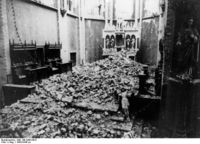
On November 9, 1938, Kristallnacht, the Jewish citizens of Bochum were attacked. The synagogue was set on fire and there was rioting against Jewish citizens. The first Jews from Bochum were deported to Nazi concentration camps and many Jewish institutions and homes were destroyed. Some 500 Jewish citizens are known by name to have been killed in the Holocaust, including 19 who were younger than 16 years old. Joseph Klirsfeld was Bochum's rabbi at this time. He and his wife fled to Palestine. In December 1938, the Jewish elementary school teacher Else Hirsch began organizing groups of children and adolescents to be sent to the Netherlands and England, sending ten groups in all. Many Jewish children and those from other persecuted groups were taken in by Dutch families and thereby saved from abduction or deportation and death.[8]
Because the Ruhr region was an area of high residential density and a center of weapons manufacturing, it was a major target of the war. Women with young children, school children and the homeless fled or were evacuated to safer areas, leaving cities largely deserted to the arms industry, coal mines and steel plants and those unable to leave.
Bochum was first bombed heavily in May and June 1943.[9] On May 13, 1943, the city hall was hit, destroying the top floor, and leaving the next two floors in flames. In November 1944, in an attack involving 700 British bombers, the steel plant, Bochumer Verein, was hit. More than 10,000 high-explosive and 130,000 incendiary bombs were stored there, setting off a conflagration that destroyed the surrounding neighborhoods.[10][11] An aerial photo shows the devastation.[12]
Downtown Bochum was a strategic target during the Oil Campaign. In 150 bomb attacks over Bochum, over 1,300 bombs were dropped on Bochum and Gelsenkirchen. By the end of the war, 38% of Bochum was decimated. 70,000 citizens were homeless and at least 4,095 dead.[11][13] Of Bochum's more than 90,000 homes, only 25,000 remained for the 170,000 citizens who survived the war, many by fleeing to other areas. Most of the remaining buildings were damaged, many with only one usable room. Only 1,000 houses in Bochum remained undamaged after the war. Only two of 122 schools remained unscathed; others were totally destroyed. Hunger was rampant. A resident of neighboring Essen was quoted on April 23, 1945 as saying, "Today, I used my last potato... it will be a difficult time till the new [autumn] potatoes are ready to be picked – if they're not stolen."[14][15]
After the war, Bochum was occupied by the British, who established two camps to house people displaced by the war. The majority of them were former Polish Zwangsarbeiter, forced laborers, many of them from the Bochumer Verein.[16]
More than sixty years after the war, bombs continue to be found in the region, usually by construction workers. One found in October 2008 in downtown Bochum caused the evacuation of 400 and involved hundreds of emergency workers.[17] A month earlier, a buried bomb exploded in neighboring Hattingen, injuring 17 people.[18]
Places of interest
Architecture
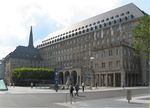
- Bochum City Hall was built from 1927–1931 and was designed by architect Karl Roth as a modern office building, but in the Renaissance style, reflecting the industrial era's middle class, inventions and discoveries. There were statues of bronze and stone, and in the city council chambers, a bell tower . The ornate décor gave the Nazis excuse to hound the then-mayor, who was of Jewish descent, driving him to suicide in 1933. Most of the bronze statues were melted down for the war effort and the stone carvings were damaged by the war, save for some small lion's heads over the entrance. Also left undamaged are two themed courtyard fountains made by August Vogel, the "Fountain of Beauty" and the "Fountain of Happiness", as well as Augusto Vasaris' florentine main entrance, which displays the motto, In Labore Honos (In labor, lies honor). In 1951, a set of 28 chimes were installed, manufactured in Bochum. Known for their clarity of tone, they are the first cast steel chimes in the world.[19] In front of the city hall is a large bell that was made by the Bochum "Verein für Bergbau und Gusstahlfabrikation AG", (Association for Mining and Cast Steel Manufacturing). Displayed at the 1867 Paris World's Fair, it has a diameter of 3.13 meters (10.27 feet) and weighs 15,000 kg (16.53 US tons). It was damaged during World War II and can no longer be rung.
- Altes Brauhaus Rietkötter, the Old Rietkötter Brewing House is one of the oldest houses in Bochum, dating from 1630. Originally a private home, it became a brewery in 1777. After nearly being torn down after the war, it now has preservation status and today, houses a restaurant, where they still make their own beer.[20]
- The Kaufhaus Kortum department store dates from 1913 and was built as one of the nearly 20 regional stores owned by Alsberg Bros. (Gebr. Alsberg, AG) of Cologne. During the Nazi era, their stores were taken away from the Jewish owners and put in non-Jewish hands. Today, the "Kaufhaus Kortum" building has preservation status and houses an electronics store.
- The Friedrich Lueg Haus was built in 1924-1925 as the first highrise in Bochum. Contracted by the Lueg Company, the seven-story building was designed by architect Emil Pohle. It suffered a fire during a bomb attack in 1944 and was renovated after the war. Today, the upper floors are small offices and internet companies. The seven-theater Bochum Union Cinema rents the ground floor, showing a variety of domestic and international films.[21]
- Mutter Wittig is a baroque-style building in downtown, originally opened as a bakery and inn in 1870. Damaged in World War II, its facade is protected by preservation status. It houses a restaurant and its windows are decorated with displays of old Bochum.[22]
- Sparkasse Bochum (Bochum Savings Bank) is a town landmark designed by architect Wilhelm Kreis. It opened in 1928 and was emblematic of the modern era. It was heavily damaged during the war, but was afterward restored to its former appearance.
- The Schlegel Tower is the only remaining structure of the once-important Schlegel brewery, which closed in 1980.
- The Jahrhunderthalle (Hall of the Century), is the former gas and power station of a steel mill built at the turn of the 20th century. With the closing of the mill, the plant was renovated and turned into a three-hall concert and event site with an industrial ambiance.[23][24]
- Dahlhauser Heide is an example of social welfare provided by wealthy German industrialists for their workers. Built in the early 1900s by the Krupp family for their coal mine workers, the modest and tastefully designed two-family houses were to enable self-sufficiency by providing gardens and a stall for a cow. The estate, which has the ambience of a small, rural town, gained preservation status in the 1970s.[25][26]
- Blankenstein Castle was built in the 13th century by Count Adolf I of Mark. Though located in Hattingen, it is owned by Bochum and is significant to its history. On June 8, 1321, Count Engelbert II of the Mark granted Bochum its town charter there. Today, only the gate and one tower remain.[27]
- Haus Kemnade is a moated castle with centuries of history. Though missing documents mean its earliest dates of construction are unknown, it is first referred to in 1393. Other parts of the castle were built during the Renaissance and baroque periods. The castle's location on the side of the Ruhr river changed when the flood of 1486 receded and left it on the opposite side, cutting it off from the neighboring village. The castle was in private hands till 1921, when it was deeded to the city of Bochum. In 1961, a museum of local history was installed, including a large collection of 16th to 20th century musical instruments. A collection of East Asian objects is also now located there, as well as a satellite of the Museum Bochum and an art exhibition space. There is also a restaurant on site. Behind the castle is a timber-framed farmhouse from 1800, now a museum exhibiting farm life from the past.[28]
Religious architecture
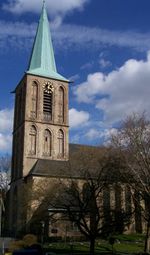
- Propsteikirche St. Peter und Paul, is the oldest church in Bochum, built between 785-800 by Charlemagne. It was rebuilt in the 11th century, but was severely damaged by fire in 1517. In 1547, it was again rebuilt, this time in the late Gothic style. The 68-meter (223 ft.) high bell tower is one of the landmarks of Bochum. The interior includes a baptismal font from 1175, the reliquary shrine of St. Perpetua and her slave Felicitas, and a high altar with a crucifix from 1352.
- Pauluskirche, is the main Protestant church of the city. After the Reformation, both Catholics and Lutherans shared the Propsteikirche, often contentiously. In 1655, the Lutherans began to build their own church with the help of donations from Holland, Sweden, Courland and Denmark. The church was heavily damaged in a bomb attack on June 12, 1943 and was later rebuilt after the war. Next to the church is a monument to peace. A statue of an old woman searching for a loved one, it is also a memorial of the November 4, 1944 bomb attack on Bochum,
- The Christuskirche, built in the neo-Gothic style, opened in 1879 and was among the most beautiful churches in Europe. In 1931, the room in the steeple was extended to a cenotaph for those killed in World War I. Hans Ehrenberg served as minister here, until he was arrested and sent to Sachsenhausen by the Nazis. During an air attack in 1943, the church was destroyed, except for the steeple. After the war, the ruins were integrated into a new, modern structure and the steeple became a memorial dedicated to peace and understanding among nations.
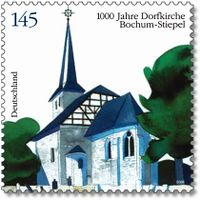
- The neo-Gothic Marienkirche, built between 1868–1872, was heavily damaged in World War II (see photo above), but was rebuilt after the war. It is now closed and scheduled for demolition. The stained glass windows have been removed and it has fallen victim to vandalism.
- Stiepeler Dorfkirche is over 1000 years old and was commemorated by a stamp in 2008. A small church consisting of one room was built by Countess Imma von Stiepel. Between 1130 and 1170, the old church was replaced with a Romanesque basilica. Today, the steeple and transept remain. Between 1150 and 1200, the interior walls and ceiling were decorated with a number of Romanesque paintings.
- The new synagoge, opened in 2007, consists of a white cube and stands in contrast to the round shape of the planetarium next door. The facade shows overall a variation of the Solomon's Seal achieved by relocated brickstones. The interior is graced by a gold-colored baldachin.
Parks and Gardens
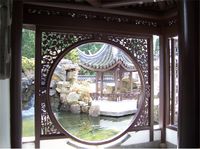
Bochum has a municipal zoo, a large municipal park and a number of other gardens and parks. The Ruhr University Botanical Gardens has thousands of plants from all over the world.[29] Among others there is a tropical garden, a cactus garden, and a Chinese garden designed in the southern Chinese style, the only one of its kind in Germany.
The Geological Garden was the first of its kind in Germany. The nearly 4-acre park is the site of an old coal mine, the Zeche Friederika, which operated from 1750 to 1907. In 1962, the property came under environmental protection and a decade later, was turned into a geological garden.[30]
Other scenic areas include the West Park, Lake Kemnade, Lake Ümmingen and the municipal forest, Weitmarer Holz.[31]
Society and Culture
Leisure and Entertainment
Bochum is a cultural center of the Ruhr region. There is a municipal theater and about 20 smaller theaters and stages. The musical Starlight Express, which opened in 1988, is the longest-running musical in Germany.[32]
Annual Events
- Jumble Sale – on the third Saturday of the month, in front of city hall
- April/May: Maiabendfest – local festival, hundreds of years old
- May: Steam Festival (every other year)
- June events:
-
- Rubissimo, Ruhr University's summer festival
- Kemnade International
- Extraschicht - Night of Industrial Heritage (many locations oll over the Ruhr area)
- June/July: VfL for Fun – summer festival for Bochum's football (soccer) team, VfL
- July: Bochum Total (Rock Music Festival) - starts on the first weekend after school lets out
- July or August: Bochum kulinarisch – culinary treats from various cuisines, held the last weekend of summer vacation
- August: Bochumer Musiksommer, Bochum's Summer of Music
- September: Open Flair - international cabaret and street theater
- October: Oktobermarkt – October Market
- October/November: Bochumer Bachtage - music of composer Johann Sebastian Bach
- October/November: Ruhrgebiets-Antiquariatstag - used and antique book sale
- November: Children's and Teenagers' Theatre
- December: Weihnachtsmarkt – Christmas Market - month-long open air market spread over the heart of downtown Bochum, includes performance stages
Museums

- The Bergbaumuseum is a museum about mining technology, complete with pithead tower.
- Railway Museum and Station Dahlhausen in the borough of Dahlhausen. Dr.-C.-Otto-Straße 191
- Zeiss Planetarium
- At the city's border with Herne-(Röhlinghausen), is the former mine Zeche Hannover with the Malakow Tower and engine hall. There is a steam-powered winding engine, which is operated at events.
- Zeche Knirps ("Small Boy Mine") located on the ground of Mine Hannover. It gives children the opportunity to experience the processes in a mine.
- Museum of local history Helf's Farm, Address: In den Höfen 37
- Farmhouse Museum located on the grounds of moated Kemnade Castle
- Museum of historic medical tools in the Malokos-Tower of former Mine Julius-Philipp from 1875. Address: Malakowturm, Markstraße 258a, 44799 Bochum
- School Museum, Cruismannstraße 2, 44807 Bochum
- Telefonmuseum, Karl-Lange-Str. 17
Art Galleries
- Museum of Art The collection's focus is central and eastearn European avant garde art, German expressionism, surrealism and outsider art. Kortumstraße 147, Bochum
- Ruhr University art collection Modern art meets the classical. Marble and bronze portraits of Greek and Roman emperors, collection of antique Greek vases from the 9th to 4th century, B.C. Universitätsstraße 150, Bochum
- Schlieker House In the former apartment and studio of German painter Hans-Jürgen Schlieker (1924–2004); changing exhibitions. Hours: Wed. & Sun. 3:00 - 6:00 pm. Paracelsusweg 16, 44801 Bochum
- Situation Kunst (Situation Art) Located at "Haus Weitmar" park. Indoor permanent exhibition with works by Gianni Colombo, Dan Flavin, Gotthard Graupner, Norbert Kricke, Lee Ufan, François Morellet, Maria Nordman, David Rabinowitch, Arnulf Rainer, Dirk Reinartz, Ad Reinhardt, Robert Ryman, Richard Serra, Jan J. Schoonhoven; also the Africa and Asia Room. Hours: Wed 2:00-6:00 pm, Fri 2:00-6:00 pm, Sat 12:00-6:00 pm, Sun 12:00-6:00 pm. Nevelstraße 29c, 44795 Bochum. Tel.: +49 (0)234-298-8901, Fax: +49 (0)234-298-8902
- Musical Instrument Collection, Hans and Hede Grumbt. Large collection of musical instruments, also the clarinet collection of Johan van Kalker. An der Kemnade 10, 45527 Hattingen, Tel.: +49 (0)2324-302-68
- Ostasiatika Collection Ehrich. Kurt Ehrich's east Asian collection of Japanese netsuke, belt buckles, a display of the seven "lucky gods" and other additional objects. An der Kemnade 10, 45527 Hattingen, Tel: (0)2324-302-68
Art in public spaces
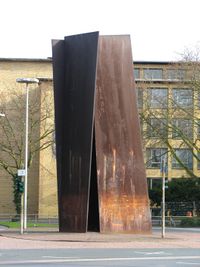
- Richard Serra's sculpture, "Terminal" is located downtown, near the central station. It consists of four 12-meter (over 39 feet) tall steel plates.
- Ulrich Rückriem's sculpture, "Ohne Titel" (titled "Untitled"), is at the intersection of Kortumstrasse and Huestrasse. (It is currently in storage because of construction.)
- Memorial of the herdsman at Massenberg-Boulevard: shown is the historical person "Fritz Kortebusch", the last herdsman of the town. In 1870 he guided the cattle of the citizens the last time to the "Vöde", a grassland outside the town limits, which is today the municipal park.
- Engelbert fountain at Kortumstrasse, in memory of Earl Engelbert II, who granted a town charter to Bochum in 1321-1324.
- Josiade-fountain at Husemann-Suare. Shown is a scene of the examination of Hieronymus Jobs, the main character of the "Jobsiade", a comical poem of the poet Carl Armold Kortum.
- "The envolvement of the City", sculpture of Professor Karl Henning Seemann at Schützenbahn street.
- Collection of sculptures inside the municipal park.
- The bell in front of the city hall reminds of the improvement of steel-casting in Bochum. The bell was built in 1867 for the Paris World's Fair.
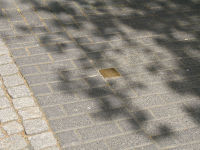
- Stolpersteine, (literally, "stumbling stones") are small, cobblestone-sized, brass commemorative plaques which are set in sidewalks all over Europe, marking the homes or work places of Jews and others who were arrested and murdered during the Nazi era. There are 38 stolpersteine in Bochum.[33]
- Cenotaph for the victims of the mine disaster at "Vereinigte Präsident" in 1936. The sculpture was created by Wilhelm Wulff. Strict guidelines for artwork were in effect during the Nazi dictatorship, yet the sculpture follows only a few them. The legend also avoids typical Nazi phrasing.
Sports
- The soccer club VfL Bochum was 14th in the First Division (1. Bundesliga) in the 2008-2009 season.
- Sparkassen Giro - annual Cycle Racing.
Economy
- Opel Car Production Plant
- Bochum has its own brewery, Moritz Fiege which produces pilsner, a low-alcohol pilsner and light-colored beers.
- RIM, manufacturer of the Blackberry, has a research and development site in Bochum.[6]
Transport
Roads
Bochum is connected to the Autobahn network by the A 40, A 43 and A 44 autobahns. In addition, Bochum has a ring road, built to expressway standards, consisting of four segments; the Donezk, Oviedo, Nordhausen and Sheffield-Ring roads. It serves as a three-quarter loop around central Bochum and begins and ends at Autobahn A40. Ruhr University Bochum is also served by an expressway running from the Nordhausen-Ring to Autobahn A43. Until 2012, a new interchange (Dreieck Bochum-West) between the Donezk-Ring and Autobahn A40 is being constructed within tight quarters due to the existence of a nearby factory.
Apart from the autobahns and expressways, there is also a small ring road around the center of Bochum, where most roads radiating out of Bochum begin. Most main roads in Bochum are multi-lane roads with traffic lights. Bochum is also served by the Bundesstraße 51 and Bundesstraße 226. B51 runs to Herne and Hattingen, and B226 runs to Gelsenkirchen and Witten.
Railways
Bochum has a central station situated on the line from Duisburg to Dortmund, connecting the city to the long-distance network of Deutsche Bahn as well as to the S-Bahn network of Rhine-Ruhr.
Bus, Tram, Underground
Local service is carried out by the BOGESTRA, a joint venture between the cities of Bochum and Gelsenkirchen. There is a single underground Stadtbahn line connecting the University of Bochum to Herne, and several tram lines connecting to Gelsenkirchen and Witten. Public transport in the city is carried out according to the fare system of the VRR transport association.
Air
Bochum is served by Düsseldorf International Airport.
Education
Higher education
- Ruhr University founded 1965
- Hochschule Bochum - Bochum University of Applied Sciences (formerly Fachhochschule Bochum)
- TFH Georg Agricola
- Evangelische FH Rheinland-Westfalen-Lippe
- Schauspielschule Bochum
- Fachhochschule des Bundes der Sozialversicherung, Abteilung Knappschaft-Bahn-See
Elementary and secondary schools
There are 61 primary schools, 9 Hauptschulen ("general schools") and 14 special schools.
In addition, there are 11 preparatory (British: grammar) schools ("Gymnasien"), 5 comprehensive schools ("Gesamtschulen"), 8 Realschulen and 2 private Waldorf schools.
"Gymnasien" – preparatory schools (British: grammar school):
- Albert-Einstein-Schule (closed after the 2009-2010 school year)
- Goethe-Schule Bochum
- Graf-Engelbert-Schule
- Gymnasium am Ostring (closed after the 2009-2010 school year)
- Heinrich-von-Kleist-Schule
- Hellweg-Schule
- Hildegardis-Schule
- Lessing-Schule
- Märkische Schule
- Neues Gymnasium Bochum (temporary name of new school formed by merger of Albert-Einstein-Schule and Gymnasium am Ostring)
- Schiller-Schule
- Theodor-Körner-Schule
"Gesamtschulen" – comprehensive schools:
- Erich Kästner-Gesamtschule Schule
- Heinrich-Böll-Gesamtschule
- Maria Sibylla Merian-Gesamtschule
- Willy-Brandt-Gesamtschule
- Matthias-Claudius-Schulen
Realschulen – high schools:
- Anne-Frank-Schule
- Annette-von-Droste-Hülshoff-Schule
- Franz-Dinnendahl-Schule
- Hans-Böckler-Schule
- Helene-Lange-Schule
- Hugo-Schultz-Schule
- Pestalozzi-Schule
- Realschule Höntrop
- Freie-Schule Bochum (with elementary school)
Waldorf schools:
- Rudolf Steiner Schule Bochum
- Widar Schule Wattenscheid
Twin towns (sister cities)
Bochum's twin towns are:
 Sheffield, United Kingdom, since 1950
Sheffield, United Kingdom, since 1950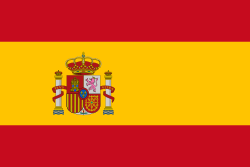 Oviedo, Spain, since 1980
Oviedo, Spain, since 1980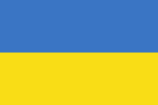 Donetsk, Ukraine, since 1987
Donetsk, Ukraine, since 1987 Nordhausen, Germany, since 1990
Nordhausen, Germany, since 1990 Xuzhou, People's Republic of China, since 1994
Xuzhou, People's Republic of China, since 1994
Notable residents of Bochum
- Wolfgang Clement (b. 1940), former Minister of Economy and Labor
- Hans Ehrenberg (1883–1958), theologian, Nazi critic, and co-founder of the Confessing Church
- Manfred Eigen (b. 1927), 1967 Nobel Prize winner in chemistry
- Tommy Finke (b. 1981), songwriter and composer
- Frank Goosen (b. 1966), cabaret artist and author, wrote Learning to Lie
- Herbert Grönemeyer (b. 1956), actor, singer, songwriter
- Else Hirsch (1889–1943), Jewish teacher who organized 10 Kindertransports to England and Holland
- Alfred Keller (1882–1974), general in the Luftwaffe during the Second World War
- Norbert Lammert (b. 1948), president (Speaker) of the Bundestag (German parliament)
- Andrei Osterman (1686–1747), Bochum-born Russian statesman
- Otto Schily (b. 1932), former Minister of the Interior
- Hans-Jürgen Schlieker (1924–2004), painter
- André Tanneberger (b. 1973), also known as "ATB", electronic music producer, began his career in Wattenscheid
- Mark Warnecke (b. 1970), breaststroke swimmer, won the world title at age 35
See also
- Bochum-Hamme
- Starlight Express
- Bermudadreieck
- International Cycling Video Festival
References
- ↑ "Amtliche Bevölkerungszahlen" (in German). Landesbetrieb Information und Technik NRW. 31 December 2009. http://www.it.nrw.de/statistik/a/daten/amtlichebevoelkerungszahlen/index.html.
- ↑ Nelson D. Schwartz. "Europe Feels the Strain of Protecting Workers and Plants" New York Times May 25, 2009. Accessed March 1, 2010
- ↑ "Nokia to close Bochum, Germany plant" boston.com, January 15, 2008. Accessed March. 1, 2010
- ↑ "Anger at Nokia swells in Germany; top politicians join fray over plant closure" Helsingin Sanomat International Edition. January 21, 2008. Accessed March 1, 2010
- ↑ Press release Germany Trade & Invest, April 23, 2008. Accessed March 1, 2010
- ↑ 6.0 6.1 "Blackberry maker RIM to set up R&D site in Bochum, add 300 jobs - report" Forbes Magazine, April 14, 2008. Accessed March 1, 2010
- ↑ "Blackberry Bold 9700 launch" Government of Canada official website. November 17, 2009. Accessed March 1, 2010
- ↑ Karin Finkbohner, Betti Helbing, Carola Horn, Anita Krämer, Astrid Schmidt-Ritter, Kathy Vowe. Wider das Vergessen — Widerstand und Verfolgung Bochumer Frauen und Zwangsarbeiterinnen 1933–1945 pp. 62-63. Europäischer Universitätsverlag, ISBN 9783932329623 (German)
- ↑ "The Final Operation – Bochum" 57 Squadron. Accessed March 8, 2010
- ↑ Chronology Official web site, Bochumer Verein. Accessed March 7, 2010
- ↑ 11.0 11.1 70 000 Obdachlose in Bochums Zentrum History of Bochum, World War II. "70,000 homeless in downtown Bochum" (November 4, 1944) Accessed March 7, 2010 (German)
- ↑ Aerial photo of Bochum, showing bombed steel plant Austrian War Memorial. Accessed March 7, 2010
- ↑ "Zahl der Kriegs- und NS-Opfer nicht mehr feststellbar" History of Bochum, World War II. (July 1, 1945) "Number of war and Nazi victims no longer ascertainable" Accessed March 8, 2010 (German)
- ↑ "Menschen kehren zurück in zerstörte Städte" History of Bochum, World War II. "People return to destroyed cities" (May 5, 1945) Accessed March 8, 2010 (German)
- ↑ [1] History of Bochum, World War II. "Main offensive on Bochum." Accessed March 7, 2010 (German)
- ↑ Wolfgang Benz and Barbara Distel. Der Ort des Terrors: Geschichte der nationalsozialistischen Konzentrationslager, Band 3 (Site of Terror: The History of Nazi Concentration Camps, Volume 3) p. 395 (2006) ISBN 9783406529634 (German)
- ↑ "10-Zentner Bombe gefunden" History of Bochum, World War II. "1000 pound bomb found." Accessed March 8, 2010 (German)
- ↑ "WWII bomb injures 17 at Hattingen construction site" The Local, German news in English. September 19, 2008. Accessed March 8, 2010
- ↑ City Hall "Historischer Rundgang Bochum - Rathaus". Accessed March 4, 2010 (German)
- ↑ Altes Brauhaus Rietkötter Official website. Accessed March 4, 2010
- ↑ Union Filmtheater Bochum Official website. Accessed March 4, 2010 (German)
- ↑ "Mutter Wittig" "Historischer Rundgang Bochum - Mutter Wittig". Accessed March 4, 2010 (German)
- ↑ Ruhr Tourism website "Jahrhunderthalle". Accessed March 4, 2010
- ↑ Jahrhunderthalle Bochum Official website. Accessed March 4, 2010 (German)
- ↑ Eugene C. McCreary. "Social Welfare and Business: The Krupp Welfare Program, 1860-1914". The Business History Review, Vol. 42, No. 1 (Spring, 1968), pp. 24-49
- ↑ Bergarbeitersiedlung Dahlhauser Heide Ruhr Guide to Dahlhauser Heide. Accessed March 4, 2010 (German)
- ↑ "Burg Blankenstein" www.ruhr-guide.de - DAS Online-Magazin für das Ruhrgebiet. Accessed March 2, 2010. (German)
- ↑ Wasserburg Haus Kemnade Official website. Accessed March 4, 2010 (German)
- ↑ Ruhr University Botanical Gardens Alphabetical list of plants, with photos. Accessed March 8, 2010.
- ↑ Bochum Geological Garden City of Bochum website. Accessed March 8, 2010 (German)
- ↑ Schöne Plätze und erholsame Orte City of Bochum website. (Beautiful and relaxing spots.) Accessed March 8, 2010 (German)
- ↑ Article about number of visitors Starlight Express website. Accessed March 8, 2010 (German)
- ↑ List of stolperstein locations in Bochum, with photos German genealogy wiki website. Retrieved May 1, 2010 (German)
External links
|
||||||||||||||||||||||||||
|
||||||||||
